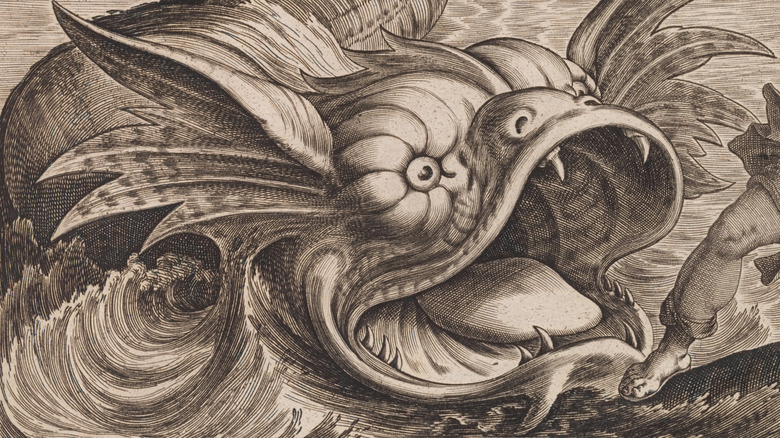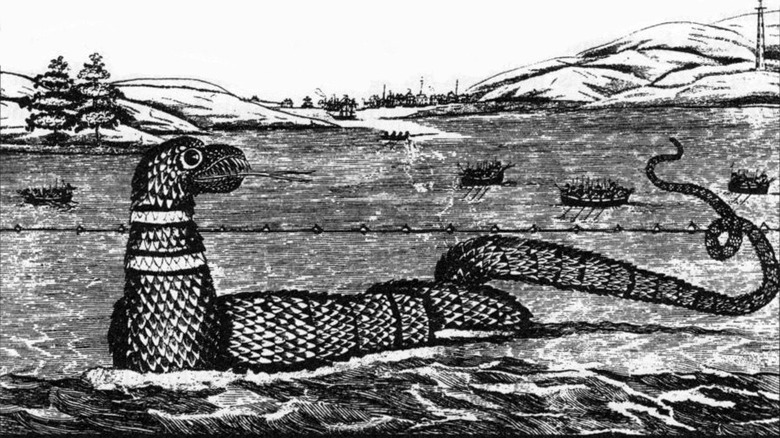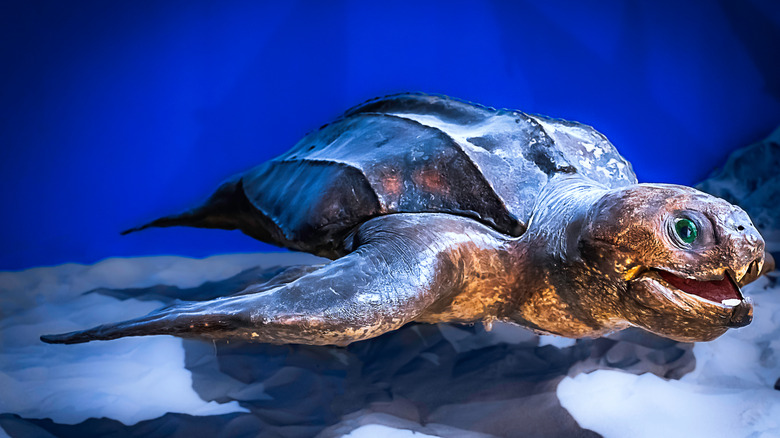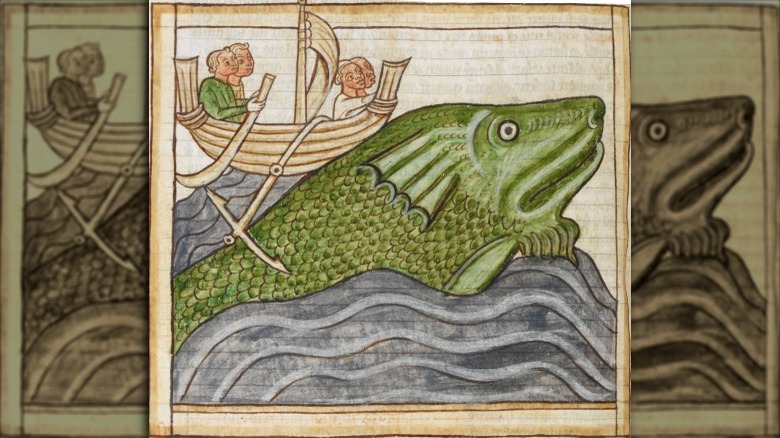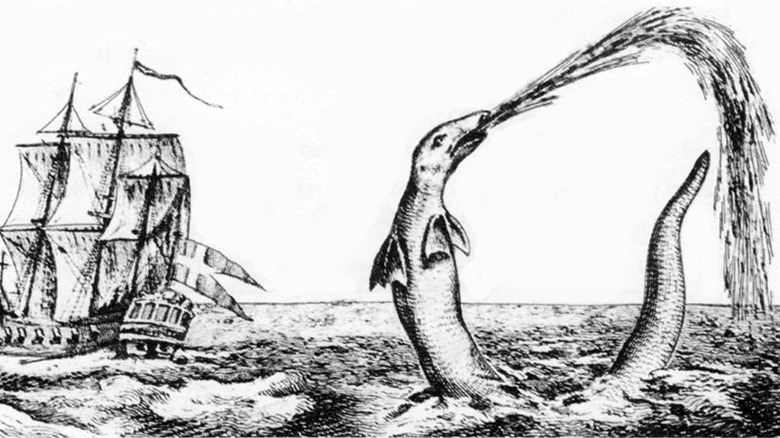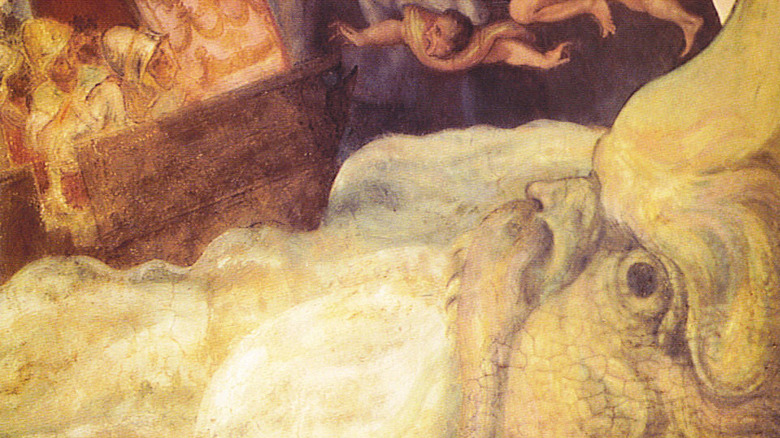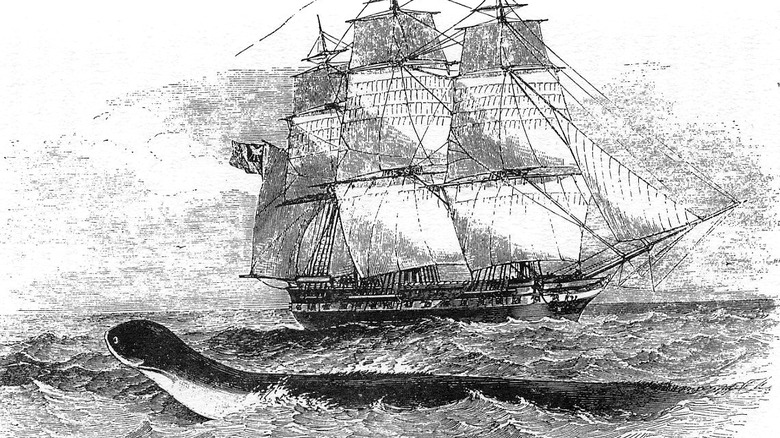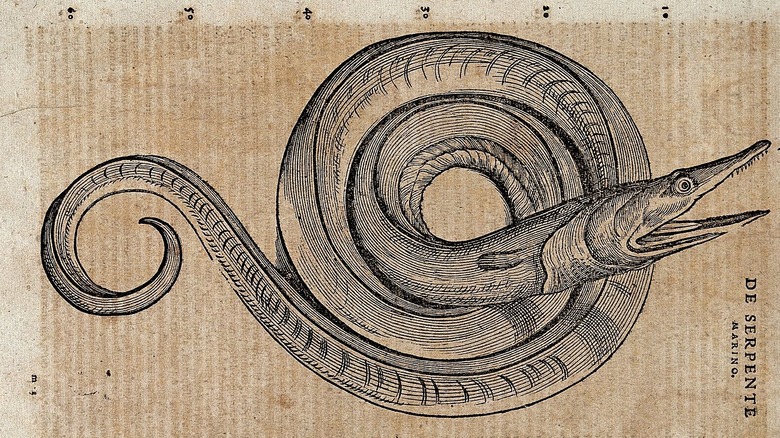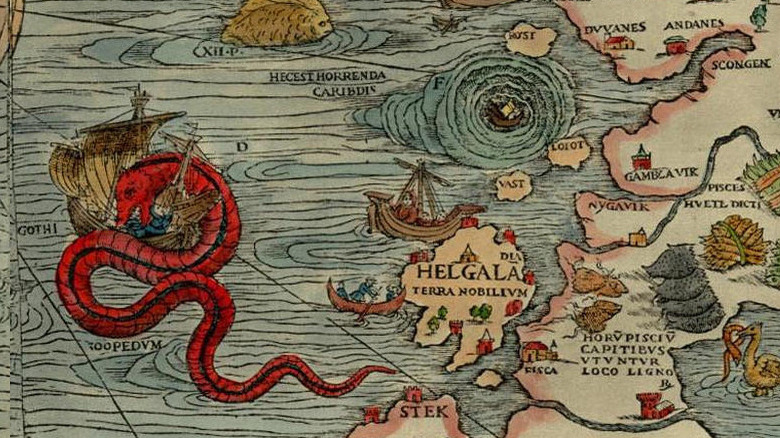The Most Believable Tales About Mythical Sea Creatures
Humankind has been telling stories about what's lurking beneath the planet's waters since we first stumbled out of our caves, fell in the ocean, and realized that it's not all it's cracked up to be. There's stuff that stings, bites, and squishes out there, and that's just on the beach. Imagine what's in the deeper waters!
And we have, with a ton of tales going back to ancient mythology, the Bible, and oral traditions that have been passed down through the ages. We're fascinated with what might be out there, and we've discovered enough to know that we might not be that far off. The National Oceanic and Atmospheric Administration says that as of 2021, less than 20% of the world's oceans have been explored. Is it possible that there's some serious sea monsters hiding in the remaining 80%? Absolutely!
For centuries, ships, sailors, and even those just observing from the safety of land have seen countless sea serpents, tentacled beasts, massive fish, and even mermaids. There are so many stories that there's gotta be something to them... right? Some are more believable than others, so let's look at some of the sea monster stories that might just have more than a grain of truth to them.
The sea serpent of 19th century Massachusetts
In late summer of 1817 — and then again in 1819 — the coast of Massachusetts was visited by a creature seen by hundreds of people. It was described as being "a SNAKE with his head and body about eight feet out of the water, his head is in the perfect shape as large as the head of a horse." Witnesses said that the serpent's body was about three feet in diameter, around 50 feet long, and that it moved in a "vertical" fashion, like a whale or dolphin might.
Originally spotted off the coast by a group of fishermen, it was initially thought to be an obvious hoax... until it got close enough to land that suddenly, people believed. During the first rash of sightings in 1817, one person even shot it in the head with a musket, because that's what you do when you meet magical, mysterious new creatures: You try to kill them.
While some modern cynics have chalked the whole thing up to mass hysteria, many others believe there was something out there. What? It's unclear, but it's been suggested that the "humped" appearance of the creature may have actually been a school of individuals that looked like a single creature from a distance. Joe Nickell of Skeptical Inquirer honed in on a part of the description that said the creature's "sting is about 4 feet in length," and suggests they were actually looking at a small group of narwhals.
The sea monster that got up close and personal
In 1959, a fisherman named Tex Geddes and his friend, an engineer named James Gavin, were boating off the coast of Scotland's Soay island. That, says Scientific American, is when they reported an honest-to-gosh sea monster surfaced a little too close for comfort. It was, they reported, between 6 and 10 feet in length, and had a head that was roughly the same size as a donkey's but shaped a bit like a turtle. They called it a "hellish monster of prehistoric times," and said that it was breathing heavily through a "large red gash of a mouth."
The story went a little pre-internet viral, and when The Illustrated London News picked it up, they included some pretty sensationalized photos that suggested the two men had seen some sort of sea dragon, complete with serpentine body and ridges along the spine. But here's the thing: based on the terrifying but slightly more realistic sketches that the men made themselves, it's entirely likely that they really did see a massive, prehistoric creature.
Namely, a turtle. Specifically, a leatherback, which is one of the few turtles that reach the sizes they described, a shell that might be exaggerated into ridged, and creepy, spiny teeth. Another (less credible) alternative is that they saw some sort of undiscovered sea turtle... or an actual, you know, sea monster. Whatever it really was, they clearly saw something.
Real or fake: The long-necked seal
One of the defining characteristics of most sea monsters and sea serpents is a long neck, and back in the 17th century, a botanist named Nehemiah Grew came up with what he thought might be an explanation for sea serpent sightings. But here's the thing: The creature he defined is just as mysterious as the sea serpents themselves.
Grew, notes The Public Domain Review, was a legitimate scientist who revolutionized everything we know about plant anatomy. When he assembled a catalogue of specimens at the Royal Society of London in the late 1600s, he included the description of a skin that had belonged to a seal that reportedly had a neck that was just as long as the rest of the body. It would explain some sea monster sightings, but there's a giant catch: The skin Grew was talking about has disappeared, and no other long-necked seals have ever been seen.
That hasn't stopped experts — like the 19th century zoologist Anthonie Cornelis Oudemans — from arguing that the specimen that Grew cataloged was what countless people had actually seen when they thought, "Sea serpent!" Even then, he was pretty thoroughly scoffed at for suggesting the idea and the long-necked seal has been relegated to the mythical, cryptozoological section of natural sciences. Still, New Scientist points out that University of London researchers estimate there's still a number of pinniped species we just haven't found yet, so... maybe Grew was right all along?
British Columbia's fish-eating mermaid
It was June of 1967, and passengers on the ferry near Mayne Island in British Columbia suddenly found themselves being treated to quite the sight. The story was reported in the Times Colonist, and not only did multiple people swear they saw a blond-haired mermaid sitting on the shore of Mayne Island, but they confirmed each other's details. She had been sitting there holding a fish — specifically, a coho salmon — and one person even thought they saw her eating it. Everyone agreed on another aspect of the sighting, too: She was completely topless. As a male witness put it: "...it was definitely a girl. Definitely."
There was photographic evidence, too, and not just the blurry, grainy kind that seems to conveniently keep happening, no matter how good cell phone cameras get. Multiple people took multiple pictures, showing exactly what everyone claimed: There was a mermaid on Mayne Island, showing the world what she had.
A $25,000 reward was offered by the Undersea Gardens, but nothing ever came of it... until they re-ran a piece on the story in 2016. That's when Times Colonist reporter Dave Obee tracked down Judy Allred, who — after telling him, "You have no life, honey," — fully admitted that she'd been the mermaid. She'd been recruited by a few locals to don a mermaid costume and sit on the rocks, all to promote a local fishing derby. And there it is: A "real" mermaid sighting.
The surprising source of an 18th century sea monster
Hans Povelsen Egede was a priest and a missionary, and he was a major player in the colonization of Greenland, says Aarhus Universitet. According to a piece published in the Archives of Natural History, Egede was well-known for drawing and documenting numerous whale species, but he was still stumped by the 1734 appearance of a "most dreadful monster."
It was Egede's son, Poul, who was on a trip from Denmark to Greenland, and reported "a very horrible sea-creature which rose itself so high over the water that the head of it reached above our big yardarm." He went on to describe a long snout, broad flippers, wrinkled, rough, and scaly skin, and a body that thrashed around in the water, and blew great gusts of breath like a whale. It followed along the ship for a bit, then dove back under the water.
He wasn't the only one to see it, and others on the ship also described a serpentine tail, red eyes, and a strange, scaly skin. Poul, too, was incredibly familiar with whales, and while he described the creature in terms of one, he also made it clear that it wasn't a whale. At least, not an entire whale. The general consensus is that Poul Egede and his crew really did see something, and that it was entirely possible that it was part of a male whale... who was just really, really happy to see them.
The mermen of Martinique
Today, the term "mermaid" brings up all kinds of images of beautiful women with long, flowing hair, but that wasn't always the case. In spring of 1671, six people claimed to have seen a merman off the coast of Martinique. He hung around — half out of the water — long enough for them to get more than a fleeting glance, and they were able to describe him really well. They agreed that he was about the size of a young teenager, was human from the waist up, and had large eyes, a snub nose, and wild, shoulder-length hair that was gray, white, and black.
According to the Edward Worth Library, the description was taken pretty seriously at the time. Six individuals agreed on what they'd seen, and once it started circulating in Europe, naturalists tried to figure out just what the heck it was. Many were careful to say that it might not be a merman... but the whole thing was weird enough that they gave themselves an out by saying that it was definitely worth researching more.
There's a good reason that their eye-witness accounts of seeing a merman were so believable: According to the Smithsonian, manatees were so commonly mistaken for mermaids that their scientific name is a reference to the mermaid's mythological cousin, the siren.
A whirlpool monster? Sounds legit...
Greek mythology seems like the last place you might look for sea monster stories that have an air of truth about them, but there actually is one that might have the biggest skeptic nodding and saying, "Yea, I can see that, if I squint a little bit." That's the story of Kharybdis, and according to Theoi, Kharybdis was a tidal demon said to be the daughter of the land and the sea, who abused her power so badly that Zeus chained her to the sea floor, where she still resides.
The believable part is what she does. Kharybdis lived in the strait between Italy and Sicily, and every day, she swallowed and then regurgitated the water. She gets a mention in numerous classics, where ill-fated travelers are faced with whirlpools and deadly currents that threaten to smash them against the rocks. Jason's tale recalled waters that "seethed and roared incessantly," while Homer's Odyssey described waters that withdrew to the sea floor.
There might not be a sea monster causing this deadly phenomenon, but anyone sailing through could believe it because it was that bad. According to the BBC, the strait was home to Kharybdis into the 19th century, and was known as a place where tides from the Tyrrhenian and Ionian seas met, creating such rocky, dangerous waters that honestly, a sea monster is almost the most believable reason for it.
The sighting that a ship's crew spent their lives trying to explain
Historian and author Matthew Willis calls the events of August 6, 1848, one of the most well-documented and credible sea monster sightings in history — and the crew of the HMS Daedalus risked everything to try to get people to believe them (via The Appendix).
Captain Peter M'Quhae gave an official report to the Royal Navy, and wrote that the ship had been approached by a creature moving fast, but close enough that he and his officers got a good look at the head and shoulders of the 60-foot-long serpent. He testified (via Skeptical Inquirer) that "the head ... was, without any doubt, that of a snake; and it was never, during the twenty minutes that it continued in sight of our glasses, once below the surface of the water." It was a dark brown fading to yellow at the throat, and he added that while there were no fins, it did have a ridge of what looked like hair down its back.
As members of the Royal Navy, M'Quhae and his crew had nothing to gain and everything to lose — and, as it turns out, they were heartily ridiculed as scientists tried explaining what they'd seen by suggesting it was something like an elephant seal — animals that lifelong Navy men would have been able to recognize. Just what they saw has never been decided, and the sighting of the HMS Daedalus remains one of the most credible.
That time Columbus saw something suspicious
Say what you will about Christopher Columbus — and people have a lot to say about him — but one thing no one can take away is that he was a legit explorer at a time when there were entire patches of the globe that were still labeled Here Be Dragons.
He was on the Atlantic Ocean in January of 1493, and on the 9th, he recorded in his journal something pretty shocking (via History): He'd seen three mermaids. And... he wasn't really impressed. He wrote (via National Geographic) that they were "not half as beautiful as they are said to be, for their faces had some masculine traits." The creatures, he claimed, "rose well out of the sea," and let's talk about where this sits on the believability scale. Did he really see something? Do we believe that there was something in the water near the Dominica Republic? Probably, but it wasn't exactly a mermaid.
As unlikely as it seems, the not-so-graceful looking manatee is capable of rising out of the water and balancing just on their tails for a short time — a move called a tail stand. Columbus wasn't alone in making the mistake, and sailors have been mixing up manatees and mermaids for a good long time. He was, perhaps, one of the first to be so downright rude about it. Manatees have feelings, too!
We've got it... now what do we do with it?
In 1968, Captain William Hagelund didn't just see a sea serpent, he caught one. His account (via the University of Southampton) testified that he had been rowing along in a small dinghy when a snake-like creature started swimming alongside. At first, he says they thought it was a sea snake, but when he saw the massive eyes and the hooked nose, he knew it wasn't. So, he grabbed a net and scooped it up.
The creature they took back on the boat had scales along its back, a fuzzy, yellow belly, and a tail that ended in two overlapping flippers. Originally planning on turning the little fella over to authorities to be studied, he wrote that as he lay awake listening to the creature splash and struggle in his bucket, he thought, "If he perished in my hands, he would only be a forgotten curiosity." Hagelund was struck by "a strong compassion for that little face staring up at me, so bravely awaiting its fate," and so, he let it go.
Hagelund's encounter was so well-documented that there ended up being 29 points of interest, so to speak. When biologists went back and tried to figure out just what it might have been, they could at least suspect that his so-called "baby sea serpent" had actually been a bay pipefish. But... they're not entirely certain. Maybe it was a baby sea serpent? We can hope!
How many times should something be seen before it's real?
When the Dutch zoologist Antoon Cornelis Oudemans started collecting sightings of the Norwegian sea serpent called the Sea Orm, he found that between the first sightings around 1555 and his writings in 1892, there were more than 300. It was first recorded by the priest and epic map-maker Olaus Magnus, says The Public Domain Review, and it's on his Carta Marina that it's depicted as wrapping itself around an entire ship.
While Olaus Magnus hadn't created it, he'd certainly heard of it and promoted the whole idea. It was copied again and again, and by 1658, it was written in another book: "They who in the Works of Navigation, or on the Coasts of Norway, ... do all agree in this strange story, that there is a Serpent there which is of a vast magnitude, namely 200 foot long, and more — over 20 feet thick and is wont to live in Rocks and Caves toward the Sea-coast about Berge..."
The Bishop of Bergen noted there was "full and sufficient evidence from credible and experienced fishermen," for the creature's existence, and well into the 19th century, sailors continued to spot the creature rising out of the sea and spitting water, tossing a mane in the air and diving back beneath the surface. There's been plenty of conjecture about just what was being described, but no one's really, really sure. But... could that many people, centuries apart, be mistaken?
